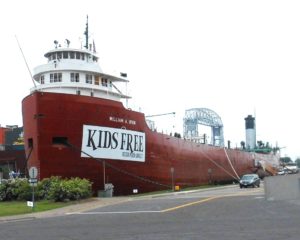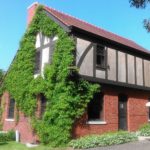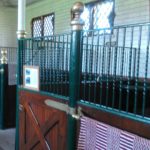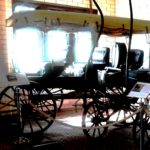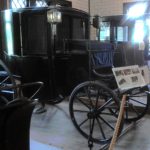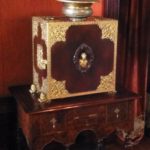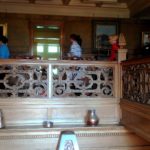It was our hope, this time as well as the last UP visit, to travel northwest into the rich copper country. But we decided, instead, to maintain our course, and the next stop was Duluth.
But that was a mistake — we spent a week in Duluth and never really connected with the city. Why we longed to go there, we can’t really recall! We visited the waterfront, the sight of another freighter-museum. And we took a tour along the waterfront on a local railroad spur turned into a tourist attraction. The train ride was to and fro for about ten picturesque miles. We rode one way in an open (chilly) car, and we went upstairs into the dome of one of the closed cars for a birds-eye view on the way back.
And we toured Glensheen, a standout attraction.
Chester Arthur Congdon (1853-1916) was a Rochester, NY born lawyer and financier. He graduated from Syracuse U. in 1875 and married a classmate, Clara, six years later. By 1892, he and Clara were in Duluth, where Chester amassed a fortune, primarily in copper and iron mining. He was a sensitive man of quiet philanthropy, but he also splurged over $850K on an estate overlooking the city. It was built between 1905 and 1908, and it has been identified as a “melding of late Victorian, Arts and Crafts and Art Noveau.” The 39 room mansion sits on 7.6 acres of Lakefront property.
One of our very favorite mansion visits is Copshaholm, the South Bend mansion of the Joseph Oliver family. Built in 1896, it remained in family hands until it became a museum with original family content. Glensheen shares the same honor; it served the family for its entire life until donated to the University of Minnesota in 1968. It even includes Chester’s top hat and some of Clara’s handwritten letters among its artifacts. Clara outlived her husband by 34 years; she was still a resident when she died in 1950 at 94.
Elisabeth Congdon, sixth of Charles and Clara’s seven progeny and last surviving member of her generation, retained residency in the home until 1977, when she and her nurse were murdered by Roger Caldwell, the second husband of her adopted daughter, Marjorie. Roger’s double-life sentence was overturned, but he confessed soon thereafter and committed suicide. Marjorie was found innocent of co-conspiracy, but she went on to a life of crime.
First contact with the estate is the Gardener’s Cottage (below left), occupied by the same family for 83 years. It’s the only building on the estate that was ever modified. It housed George Wyness, hired in 1921 to be the family gardener, and the cottage was later enlarged for his growing family. His son, Bob, took over the clippers for his dad and was the last person to live on the property, departing in 2004 with his wife Elsie for a retirement home.
Next, the Carriage House, which now serves as tour-central. One first passes through the stables, then moves on to the vehicle room with numerous carriages and a motor car, perched on an elevator that took it to its upper-floor storage. The yellow-topped is a Studebaker Mountain Wagon, purchased in 1907, a South Bend product that preceded their auto manufacture.
Our trip through the mansion allowed very limited photo opportunities. On the other hand, it treated our eyes to the exquisite trappings that money can bring. Clara had a strong hand in the selection of interior treatments and both Congdons had a fondness for landscaping. It was truly worth the stop.
- Gardener’s Cottage
- Lake side
- Stables
- Studebaker Wagon
- Surrey
- What is it?
- Interior
- Balcony
- Garden


